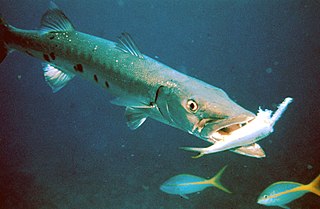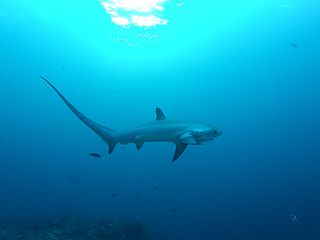
The megamouth shark is a species of deepwater shark. Rarely seen by humans, it measures around 5.2 m (17 ft) long and is the smallest of the three extant filter-feeding sharks alongside the relatively larger whale shark and basking shark. Since its discovery in 1976, fewer than 100 specimens have been observed or caught. Like the other two planktivorous sharks, it swims with its mouth wide open, filtering water for plankton and jellyfish. It is recognizable from its large head with rubbery lips. The megamouth is so unlike any other type of shark that it is usually considered to be the sole extant species in the family Megachasmidae, though some scientists have suggested it may belong in the family Cetorhinidae.

A barracuda is a large, predatory, ray-finned fish known for its fearsome appearance and ferocious behaviour. The barracuda is a saltwater fish of the genus Sphyraena, the only genus in the family Sphyraenidae, which was named by Constantine Samuel Rafinesque in 1815. It is found in tropical and subtropical oceans worldwide ranging from the eastern border of the Atlantic Ocean to the Red Sea, on its western border the Caribbean Sea, and in tropical areas of the Pacific Ocean. Barracudas reside near the top of the water and near coral reefs and sea grasses. Barracudas are targeted by sport-fishing enthusiasts.

Thresher sharks are large mackerel sharks of the family Alopiidae found in all temperate and tropical oceans of the world; the family contains three extant species, all within the genus Alopias.
The Pacific saury is species of fish in the family Scomberesocidae. Saury is a seafood in several East Asian cuisines and is also known by the name mackerel pike.

Rajiformes is one of the four orders in the superorder Batoidea, flattened cartilaginous fishes related to sharks. Rajiforms are distinguished by the presence of greatly enlarged pectoral fins, which reach as far forward as the sides of the head, with a generally flattened body. The undulatory pectoral fin motion diagnostic to this taxon is known as rajiform locomotion. The eyes and spiracles are located on the upper surface of the head and the gill slits are on the underside of the body. Most species give birth to live young, although some lay eggs enclosed in a horny capsule.

The Japanese bullhead shark is a species of bullhead shark in the family Heterodontidae found in the northwestern Pacific Ocean off the coasts of Japan, Korea, and China. This benthic shark occurs at depths of 6–37 m (20–121 ft) over rocky bottoms or kelp beds. Measuring up to 1.2 m (3.9 ft) long, it can be identified by its short, blunt head, two high dorsal fins with anterior spines, and pattern of irregularly shaped, vertical brown bands and stripes. The Japanese bullhead shark is a docile, slow-swimming species that feeds mainly on shelled invertebrates and small bony fishes. Reproduction is oviparous, with females laying spiral-flanged eggs in communal "nests". This species is of little interest to fisheries.

The blotchy swellshark, or Japanese swellshark, is a common species of catshark, belonging to the family Scyliorhinidae. The Blotchy swellshark is found at depths of 90–200 m (300–660 ft) in the northwestern Pacific Ocean, from Japan to Taiwan. It is benthic in nature and favors rocky reefs. Reaching 1.4 m (4.6 ft) in length, this thick-bodied shark has a broad head, large mouth, and two unequally-sized dorsal fins positioned far back past the pelvic fins. It can be identified by its dorsal coloration, consisting of seven brown "saddles" and extensive darker mottling on a light tan background. This species has often been confounded with the draughtsboard shark and the Sarawak pygmy swellshark in scientific literature.

The banded houndshark is a species of houndshark in the family Triakidae, common in the northwestern Pacific Ocean from the southern Russian Far East to Taiwan. Found on or near the bottom, it favors shallow coastal habitats with sandy or vegetated bottoms, and also enters brackish water. This shark reaches 1.5 m (4.9 ft) in length. It has a short, rounded snout and mostly narrow fins; the pectoral fins are broad and triangular, and the trailing margin of the first dorsal fin is almost vertical. It is gray above and lighter below; younger sharks have darker saddles and dots, which fade with age.

The blackspotted catshark is a catshark of the family Scyliorhinidae. It is found in the waters off the coasts of Japan, Korea, China, and Taiwan between latitudes 39° N and 20° N, at the depths of between 80 and 100 m. It can grow up to 49 cm in length.

The gecko catshark is a species of catshark, part of the family Scyliorhinidae, native to the northwestern Pacific Ocean from southern Japan to Taiwan, and possibly also off Vietnam. It is a common, demersal species found at depths of 100–900 m (330–2,950 ft). Its body is slender, with a pattern of dark saddles and blotches. The dorsal and caudal fins are edged in white, and there is a prominent crest of enlarged dermal denticles along the dorsal edge of the caudal fin. The gecko catshark is a schooling, opportunistic predator of bony fishes, cephalopods, and crustaceans. It is oviparous, with females producing two vase-shaped egg capsules at a time. This species is captured as bycatch, but does not appear to be threatened by fishery activities at present and has been assessed as Least Concern by the International Union for Conservation of Nature (IUCN).

The blacktip sawtail catshark is a species of catshark, and part of the family Scyliorhinidae, found off the coasts of Taiwan and the Philippines. It is demersal in nature and occurs deeper than 60 m (200 ft). Growing up to 46 cm (18 in) long, this slim-bodied species is characterized by its plain brownish dorsal coloration with dark tips on the dorsal and caudal fins, and a prominent crest of enlarged dermal denticles on the upper edge of the caudal fin. It is oviparous, with females producing encapsulated eggs two at a time year-round. The blacktip sawtail catshark is caught incidentally in bottom trawls and used for fishmeal in Taiwan.

The Taiwan angelshark is an angelshark in the family Squatinidae. The Taiwan angelshark is one of four species of Squatina in the waters around Taiwan and Japan. It is a demersal, ray-like shark that grows to 1–2 meters in length.

The Japanese angelshark is a species of angelshark, family Squatinidae, found in the northwestern Pacific Ocean off China, Japan, and Korea. It is a bottom-dwelling shark found in sandy habitats down to 300 m (980 ft) deep. This species has the flattened shape with wing-like pectoral and pelvic fins typical of its family, and grows to 1.5 m (4.9 ft) or more in length. Its two dorsal fins are placed behind the pelvic fins, and a row of large thorns occurs along its dorsal midline. Its upper surface is cryptically patterned, with numerous squarish dark spots on a brown background.
The arrowtooth grenadier is a species of rattail. This is a deep-water fish found at depths of up to 950 m. It was originally recorded from the waters around Hawaii but has recently also been recorded near Taiwan, which suggests it has a far wider distribution than previously thought.
The plainfin grenadier is a species of rattail. This is a deep-water fish found at depths of up to 772 m. It has a wide distribution in the Indian and western Pacific Oceans.
The Palau grenadier is a species of rattail. This is a deep-water fish found at depths of up to 710 m. It has been recorded from many parts of the Pacific Ocean including Hawaii, southern Japan, the Kyushu–Palau Ridge and northeastern Taiwan.
Ventrifossa rhipidodorsalis is a species of rattail. This is a deep-water fish found at depths of up to 535 m. It is found in waters off southern Japan, northeastern Taiwan, the Philippines, and in the South China Sea.

The Roanoke logperch is a species of freshwater ray-finned fish, a darter from the subfamily Etheostomatinae, part of the family Percidae, which also contains the perches, ruffes and pikeperches. It is found in the Roanoke and Chowan drainages in Virginia and North Carolina in the United States. It inhabits low and moderate-gradient streams and rivers in warm, clear water in mostly unsilted gravel and rubble in runs, pools, and riffles. It is primarily insectivorous. This fish is a federally listed endangered species.

The longfin grouper, also known as the longfin rockcod, bar-breasted rock-cod, Gilbert's rock-cod, honeycomb rockcod, spotted groper or wirenet cod, is a species of marine ray-finned fish, a grouper from the subfamily Epinephelinae which is part of the family Serranidae, which also includes the anthias and sea basses. It is found in the Western Pacific Ocean.

The Indonesian angelshark is a rare species of angelshark, family Squatinidae, known only from a few specimens collected from fish landing sites in southern Indonesia. It is thought to inhabit the deep waters of the continental slope. Reaching at least 1.34 m (4.4 ft) long, this species has a flattened, ray-like shape and a well-developed tail and caudal fin. It is characterized by the absences of fringes on its nasal barbels and thorns down the midline of its back, as well as by its relatively plain grayish-brown dorsal coloration with dark saddles beneath the dorsal fin bases and a black leading margin on the underside of the pectoral fins. The International Union for Conservation of Nature (IUCN) has classified it as Critically Endangered due to significant fishing pressure.














